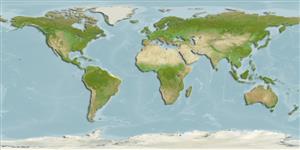Common names from other countries
Environment: milieu / climate zone / depth range / distribution range
Sinh thái học
; Mức độ sâu 1 - 10 m (Ref. 3086). Tropical
Circumtropical.
Length at first maturity / Bộ gần gũi / Khối lượng (Trọng lượng) / Age
Maturity: Lm ? range ? - ? cm
Complementary nematocysts microbasic euryteles, having a much ornamented shaft; male blastostyles completely reduced, with distinct neck connecting gonophore chambers; female blastostyles fully reduced, spadix unbranched during early ontogeny, shed when mature; eggs with thin pellicle, placed along axis of blastostyle (Ref. 3086).
Maximum depth from Ref. 3100. Occurs in shallow waters from 1 to 10 m in depth, on rocks and barnacles (Ref. 3086 and 3100). It prefers shaded microhabitats and current flows, where it can form extensive meadows (Ref. 3101).
Life cycle and mating behavior
Chín muồi sinh dục | Sự tái sinh sản | Đẻ trứng | Các trứng | Sự sinh sản | Ấu trùng
Members of the order Anthoathecata are mostly colonial A-form hydroids. Life cycle: The zygote develops into planula inside the gonophore and is later released as an actinula which metamorphoses into polyp stage.
Migotto, A.E., A.C. Marques, A.C. Morandini and F.L. da Silveira. 2002. (Ref. 813)
IUCN Red List Status (Ref. 130435)
CITES status (Ref. 108899)
Not Evaluated
Not Evaluated
Threat to humans
Harmless
Human uses
| FishSource |
Các công cụ
Thêm thông tin
Age/SizeSự sinh trưởngLength-weightLength-lengthHình thái họcẤu trùngSự phong phú
Các nguồn internet
Estimates based on models
Preferred temperature
(Ref.
115969): 17.8 - 25.9, mean 19.3 (based on 285 cells).
Price category
Unknown.
